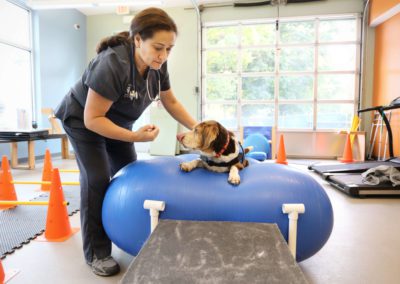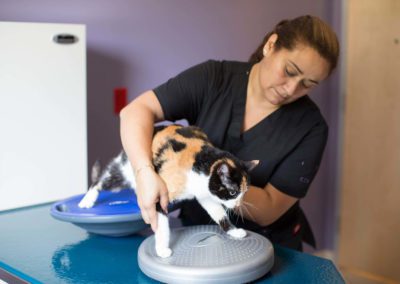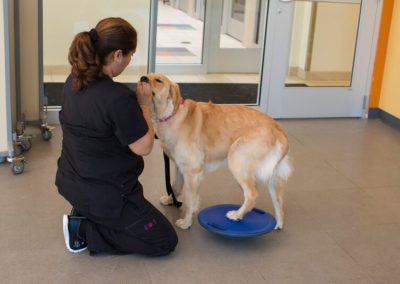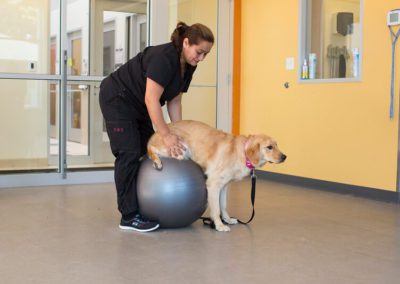Canine Rehabilitation & Pain Management
Meet Our Canine Rehabilitation Therapist

Dr. Eliana Cely, DVM, CCRT
Dr. Eliana Cely earned her degree in Veterinary Medicine from Universidad De La Salle Colombia. She completed one year in a small animal rotating internship at Universidad Nacional Autónoma de Mexico (UNAM) and completed her residency in internal medicine and surgery at Universidad Autónoma del Estado de Mexico (UAEM). While she was studying in Colombia and Mexico, she worked closely with patients rehabilitating from neurological and orthopedic problems.
Dr. Cely became certified in Canine Rehabilitation & Pain Management from the Rehabilitation Institute (CRI) in Florida. She is one of the only veterinarians in the Western New York area who is certified in canine rehabilitation & pain management! She also has two cats, Pulga and Simon.
The goal of our canine rehabilitation & pain management therapist, Dr. Cely, CCRT, and her team is to help improve quality of life, decrease pain and discomfort, help restore normal movements, promote fitness, and improve muscle strength and joint flexibility through the implementation and modification of therapeutic exercises.
During the first appointment, your pet will receive a complete physical exam, as well as a comprehensive evaluation. This includes an orthopedic and neurological assessment to determine your pet’s specific needs, prognosis, and treatments indicated. Most of the recommended treatments can be completed on an outpatient basis, with some immediate post-surgical cases requiring hospitalization. Our patient’s owners play an integral role in their pet’s treatment by performing strength, conditioning, and other exercises at home following detailed demonstrations by the therapy team. It is this coordination between therapist, owner, and patient that will maximize the potential for a successful outcome!
Canine rehabilitation & pain management sessions include:
(therapeutic sessions will be tailored to each individual patient based on condition)
- Underwater treadmill
- Laser therapy
- Acupuncture (with Dr. Bork, cVMA)
- Intra-articular injection
- Passive therapy
- TENS (transcutaneous electrical nerve stimulation)
Massage (3 are offered: Relaxing, Therapeutic, Sport) - Heat and cold therapy
Passive range of motion exercises - Joint mobilization
- TENS (transcutaneous electrical nerve stimulation)
- Active therapy
- Stretching
- Muscle strengthening (weights, TheraBand)
- Conditioning (Physioballs, peanut balls, BOSU balls, wobble board, balance disc, hydraulic balance board)
- Conditioning for Sport and Working Dogs
- Fitness
- Individualized home therapy and rehab programs
Each patient is specifically evaluated by Dr. Cely, CCRT, and an individualized therapy plan is then created. The plan is customized to the unique needs of your pet. Each pet also receives a specific home rehabilitation program to continue therapy while not at the clinic.
Canine Rehabilitation & Pain Management Forms
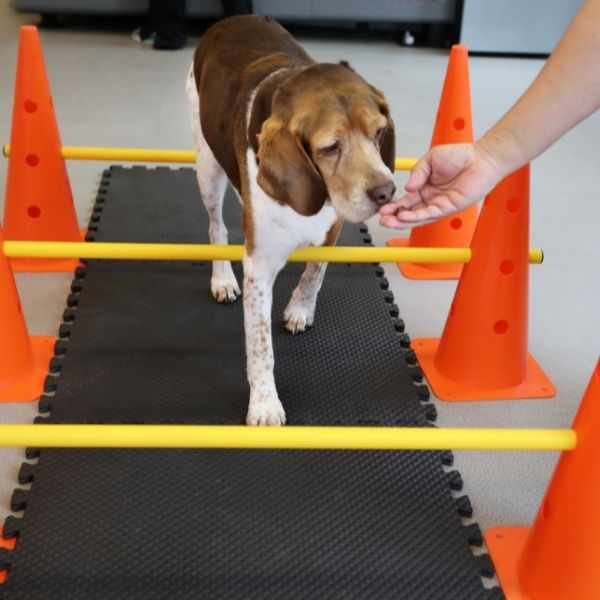
Who can benefit from canine rehabilitation & pain management therapy?
All pets can benefit from canine rehabilitation & pain management therapy! Both dogs and cats, young and old can be affected by pain or injury. Both acute and chronic injuries can greatly benefit as well!
- Geriatric patients
- Surgical rehabilitation (both pre and post-operative)
- Injured non-surgical patients
- Obese patients (fitness guidance and health education)
- Hip or elbow dysplasia
- Patellar luxation
- Muscle, tendon, ligament sprain or strain
- Chronic degenerative disease
- Neurologic patients
- Orthopedic patients (fractures, amputations)
- Canine athletes
- Working dogs
- Alternative to surgical or medical management
- Arthritis
- Cats!
- THESE ARE JUST TO NAME A FEW! This is a limited list; many conditions can benefit from canine rehabilitation & pain management therapy
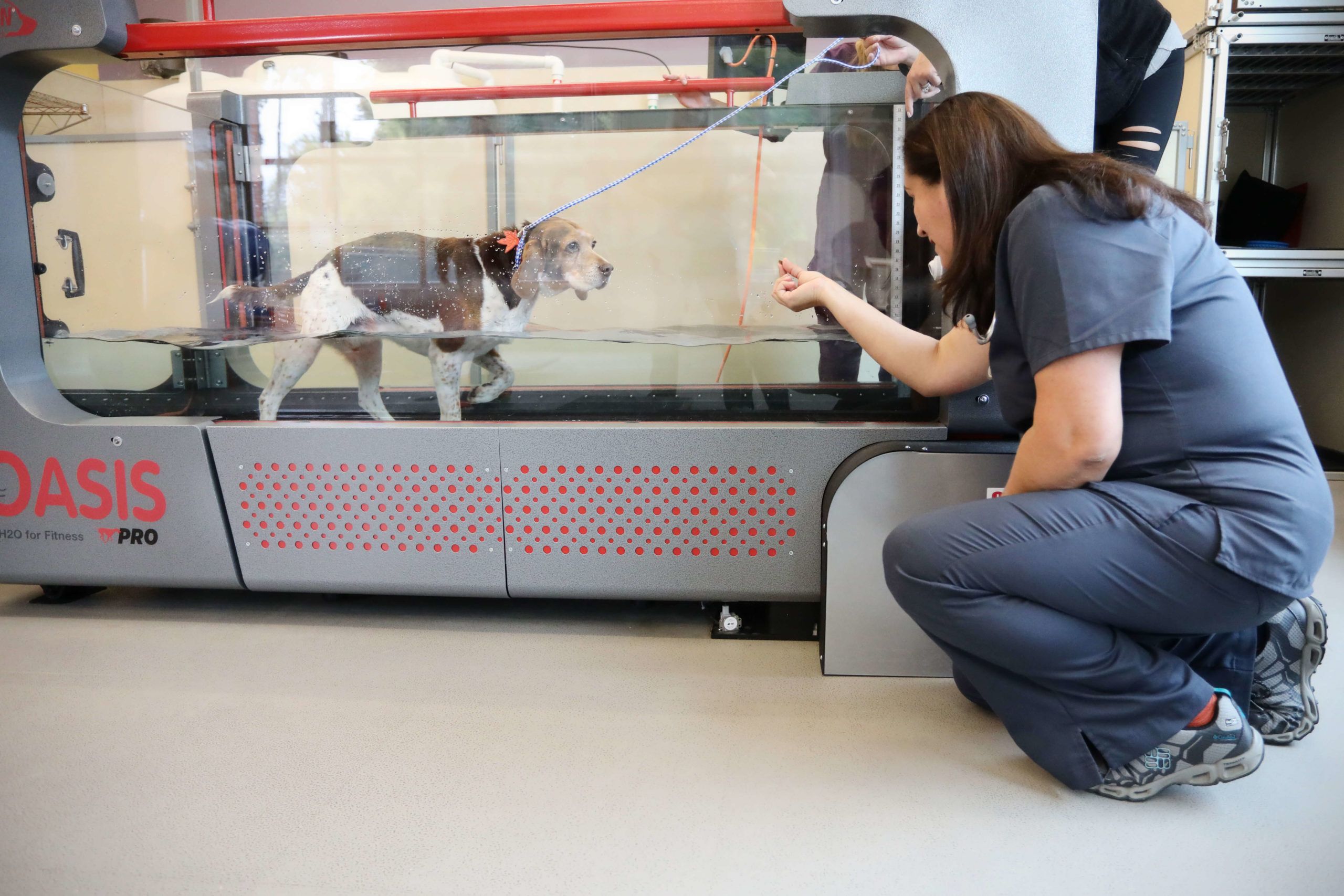
Therapeutic Modalities:
Underwater Treadmill
Through the utilization of our underwater treadmill, we can help to improve an orthopedic or neurologic condition, restore dysplastic function after a surgical procedure, improve fitness and health, provide comfort in geriatric or painful pets, or just be an enjoyable form of exercise.
The chemically balanced water in the treadmill aids in supporting the weight of the patient during a session. The gentle movement of the belt stimulates motion allowing for non-traumatic and comprehensive exercise training. Treadmill use can improve a patient’s core strength, endurance, and helps build muscle. We also see improvements with joint mobility along with overall gains in cardiovascular fitness.
The treadmill has adjustable options, including jets, inclines, and variable speeds to customize an individual patient’s therapeutic needs.
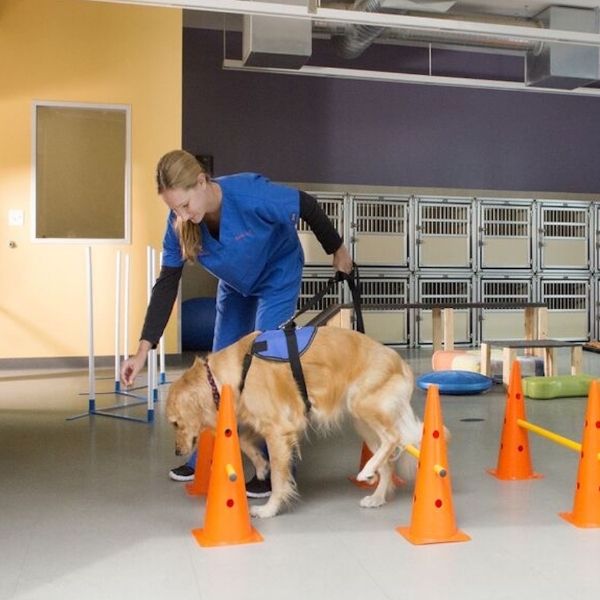
Who can benefit from an underwater treadmill?
- Geriatric patients
- Surgical rehabilitation (pre and post-operative)
- Injured non-surgical patients
- Obese patients (fitness guidance and health education)
- Hip and elbow dysplasia
- Patellar luxation
- Muscle, tendon, ligament sprain or strain
- Chronic degenerative disease
- Neurologic patients
- Orthopedic patients (fractures and amputations)
- Canine athletes
- Working dogs
- Alternative to surgical or medical management
- Cats!
This is just to name a few!
What occurs during an underwater treadmill session?
Each patient using the underwater treadmill is accompanied by a team member at all times wearing a buoyant harness to ensure water safety. The water temperature is kept at a comfortable therapeutic degree, which can help to decrease pain, increase blood flow, and relax muscles. The water level used to immerse a patient is based on the animal’s size, comfort in the water, and therapeutic goal for the session.
Session times will vary based on the patient’s needs and physical abilities. Treats are allowed to encourage and reward our amazing patients.
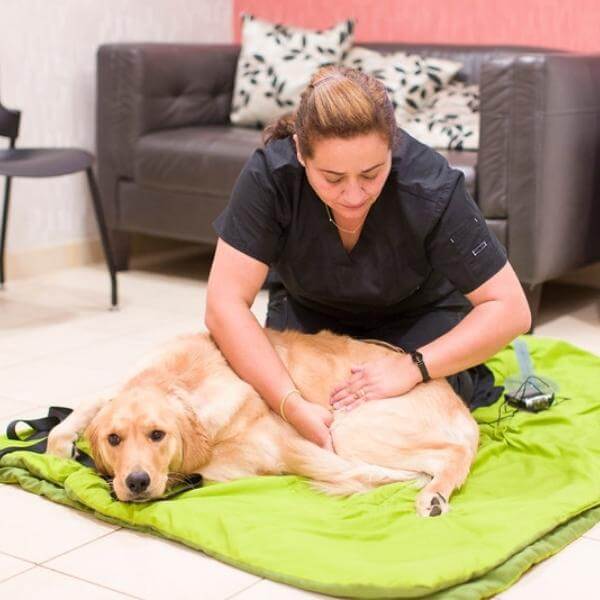
Massage Therapy
You may also consider a therapeutic massage for your pet. Dr. Cely, CCRT offers 3 different types of massage, depending on your goal.
Massage therapy is meant to help relieve stress and relax muscles in a patient. With specific massage techniques, muscle spasms, aches, and pains are reduced. As a result, range of motion and circulation are improved.
Relaxing Massage (15 MIN) or (30 MIN)
Dr. Cely, CCRT utilizes effleurage (a form of massage that involves the palm of your hand creating a circular motion), light wringing, and circular massage techniques.
Regular massage maintains a dog’s general well-being and can provide early detection of health changes.
Therapeutic Massage (20-30 MIN)
By running her hands and fingertips over areas to feel for tenderness, swelling, or other abnormalities, Dr. Cely, CCRT scans for lumps, sores, swellings, or reactions such as snapping, flinching or crying out. This routine can be utilized in conjunction with a relaxing massage, allowing for a release of endorphins (natural healing hormones) promoting a feeling of contentment and comfort that can extend well into the day and evening.
Sports Massage (15 MIN)
The goal of this massage is to invigorate muscles, increase blood flow, and prepare the body for strenuous activity (agility, swimming, or long runs).
Canine athletes are better prepared for and recover more quickly afterward when massage is a regular component of the training program. Massage helps prepare dogs mentally and physically for the event and reduces the chance of injury. Massage also comforts tired muscles and reduces the potential for cramping and post-exercise soreness.
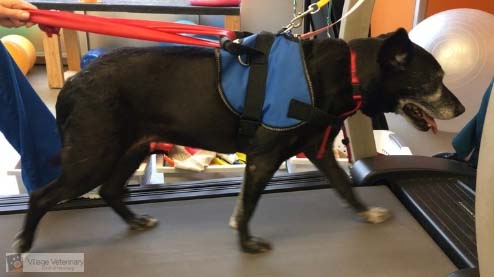
Land Treadmill
The land treadmill helps improve how your pet walks. It will force them to weight bear and balance on all four of their legs. The goal is to improve balance, coordination, and normalize how they walk. As they stride with the speed of the treadmill, their muscles flex and extend more than they would if they were walking on their own.
Shockwave Therapy
Shockwave is a new service we offer here at Village Veterinary Clinic of Hamburg. It is a noninvasive, high-energy sound wave treatment commonly used in human and veterinary medicine. It can help patients by relieving pain and speeding healing. Learn more about it here.
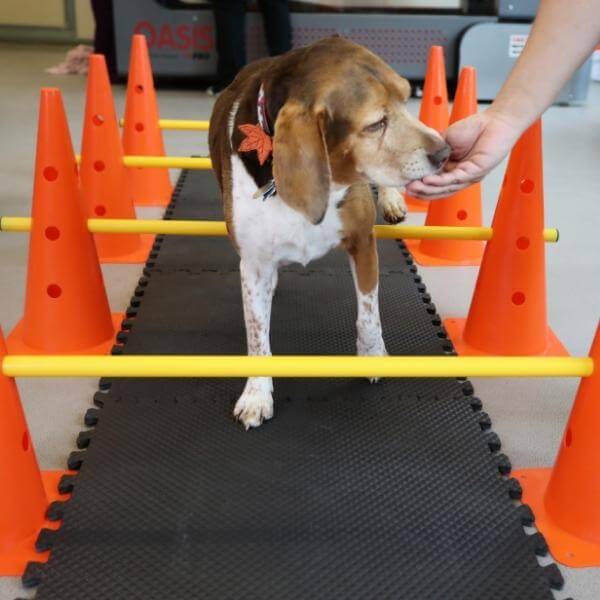
Cavaletti’s
Cavaletti’s help with range of motion and proprioception. When they cross over each pole they need to lift a leg. This requires balance, awareness of what their feet and bodies are doing, and the ability to shift their weight.
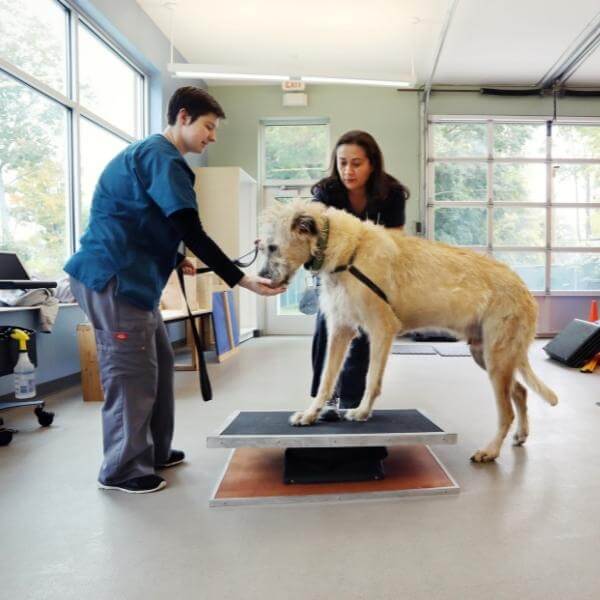
Balance Board, Wobble Board, Hydraulic Balance Board
This can help with balance and proprioception or awareness of their body position. It can also help with leg and core strength. When a pet stands on the rocker board it still rocks from side to side. They must try to resist the movement and maintain their balance.
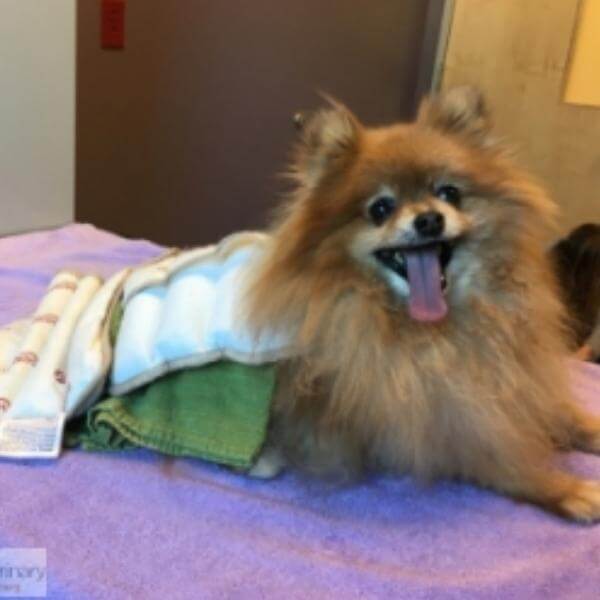
Heat and Cold Therapy
Cold therapy can help reduce pain, swelling, and muscle spasms.
Heat therapy can provide pain relief to the area of concern. It will also decrease muscle spasms, stiffness, and increase muscle elasticity and blood flow.
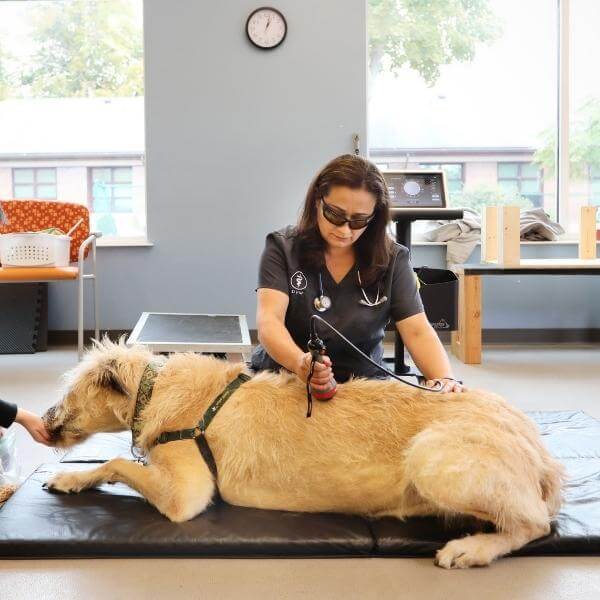
TENS (Transcutaneous Electrical Nerve Stimulation)
Electrotherapy can be used to reduce pain and inflammation, wound healing, muscle re-education, and muscle atrophy and strengthening. TENS is non-painful, non-invasive electrical currents. The TENS unit delivers a current to the patient through electrodes, which are placed on the skin. The TENS then stimulates the nerves with an electrical impulse. During the stimulation it causes the muscles to strengthen and be re-educated. It also has pain-relieving capabilities.
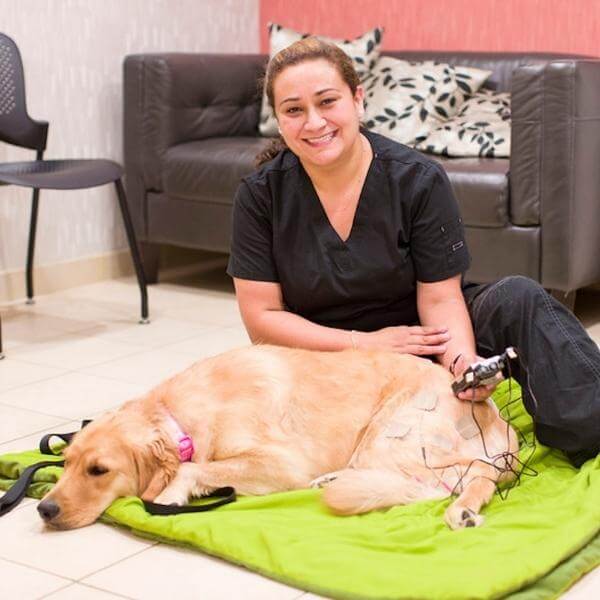
Laser Therapy
Laser therapy can help reduce inflammation and pain. It will also help speed healing time.
Laser therapy uses light to go deep into your tissues and work on your body on a cellular level (yes, we are talking mitochondria… cell biology coming back to you?). All dogs, cats, and even humans have parts of their cells that produce energy, and when they are stimulated by the light from the laser it causes a change called “photo-bio-modulation”. During that whole process, your body starts to release endorphins, stimulates injured cells to heal, and also helps itself to relieve any pain sensations.
It also causes the production of ATP. ATP is the fuel and energy needed by cells for repair and rejuvenation. When cells have been injured they cannot make ATP, which can lead to improper, slow, or no healing at all. When using the laser, it can stimulate the cells to produce ATP again!
All our Canine Rehabilitation & pain management patients get laser therapy as part of their therapy.
To learn more about laser therapy, click here to visit our VVC webpage.
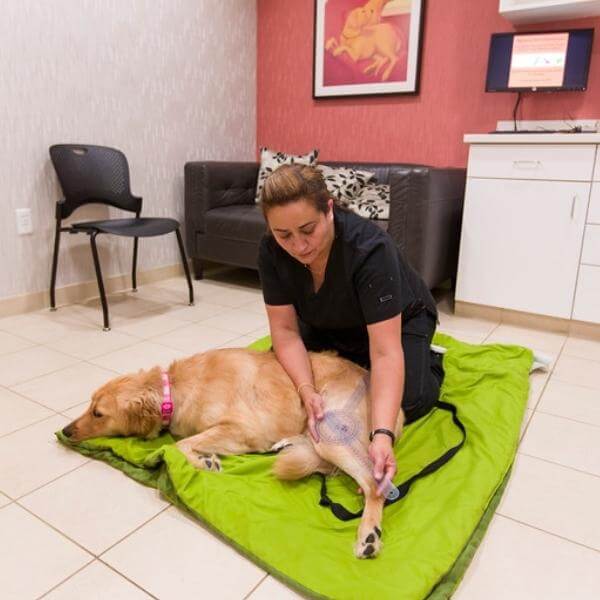
Range of Motion – Passive and Active Canine Rehabilitation
Range of motion exercises can be applied actively or passively. Active range of motion exercises patients performs various exercises to increase flexibility and range of motion. With a passive range of motion, a therapy team member guides the patient through a motion. This can help with flexion, extension, and range of motion.
To determine if the range of motion is improving measurements are taken. An instrument called a goniometer is used at the patient’s first visit and monitored throughout their sessions to determine the effectiveness of the treatments.
Meet Our canine rehabilitation & pain management team
Licensed Veterinary Technicians: Kristen CCRP, Kara, Kira, Kelsey
Assistants: Ashley, Kelsey, Jade, Jackie

